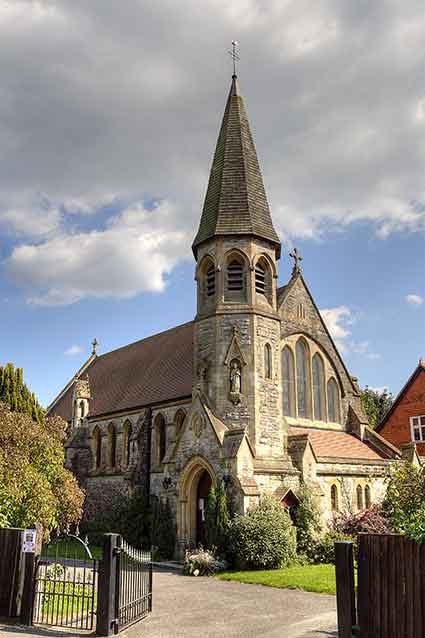Lyndhurst Catholic Church - Our Lady of the Assumption and St. Edward

After many years of persecution, it was only at the beginning of the 19th century that the Roman Catholic Church began to expand in Britain, from a base of less than 100,000 members. By 1840, Irish immigration had helped swell numbers to around 250,000, and the increase continued during the 1845 Irish famine, and beyond.
Expansion of the congregation in the second half of the 19th century was reflected by the opening of Our Lady of Mercy and St. Joseph, Lymington, and Lyndhurst’s Roman Catholic Church - Our Lady of the Assumption and St. Edward - at the end of that century.
Constructed in 1895/1896, the Lyndhurst Catholic Church is on the corner of Empress Road and Pemberton Road – from the traffic lights at the top of the High Street, take the second road on the right off the main road leading to Cadnam. Prior to that, monthly Mass had been celebrated in a building in Wellands Road, overseen by the priest from Lymington.
The church was built at the behest of Edouard Souberbielle, a French doctor who funded the costs in memory of his wife Marie Louise, who died whilst on holiday in the village, and is buried in the church’s mausoleum. A plaque to her memory can be found on the outside wall of the church, whilst in the porch another plaque records that the bells were installed in her memory on the 1st July, 1897.
Marble mosaic work, a prominent feature of the aisle and sanctuary, was completed by Italian craftsmen specially brought over for the project.
The west window rather poignantly commemorates men of the ‘Immortal 7th Division’, who in 1914, before setting off to fight in the First World War, camped on White Moor, near Bolton’s Bench, and on Lyndhurst’s old Race Course. In October of that year, about 15,000 of them sailed from Southampton to France, heading for the battlefields of Ypres. Three weeks after going into action, there were only 2,380 left.
Details of services can be found at this link.
References:
Lyndhurst Historical Society publications: Roy Jackman
Lyndhurst – A Brief History and Guide: Georgina Babey and Peter Roberts
More links
Other related links
Search this site

Sadly, 58 animals were killed - 35 ponies, 13 cows, 8 donkeys and 2 sheep, whilst a further 32 were injured - 3 pigs, 9 donkeys, 11 cows and 9 ponies.
(Forty-three accidents occurred in daylight, 15 at twilight and 101 in the dark. Twenty-seven accidents were not reported by the driver involved).
Here's just one horrific example - Three donkeys killed in collision with van at notorious New Forest blackspot (Advertiser and Times)

